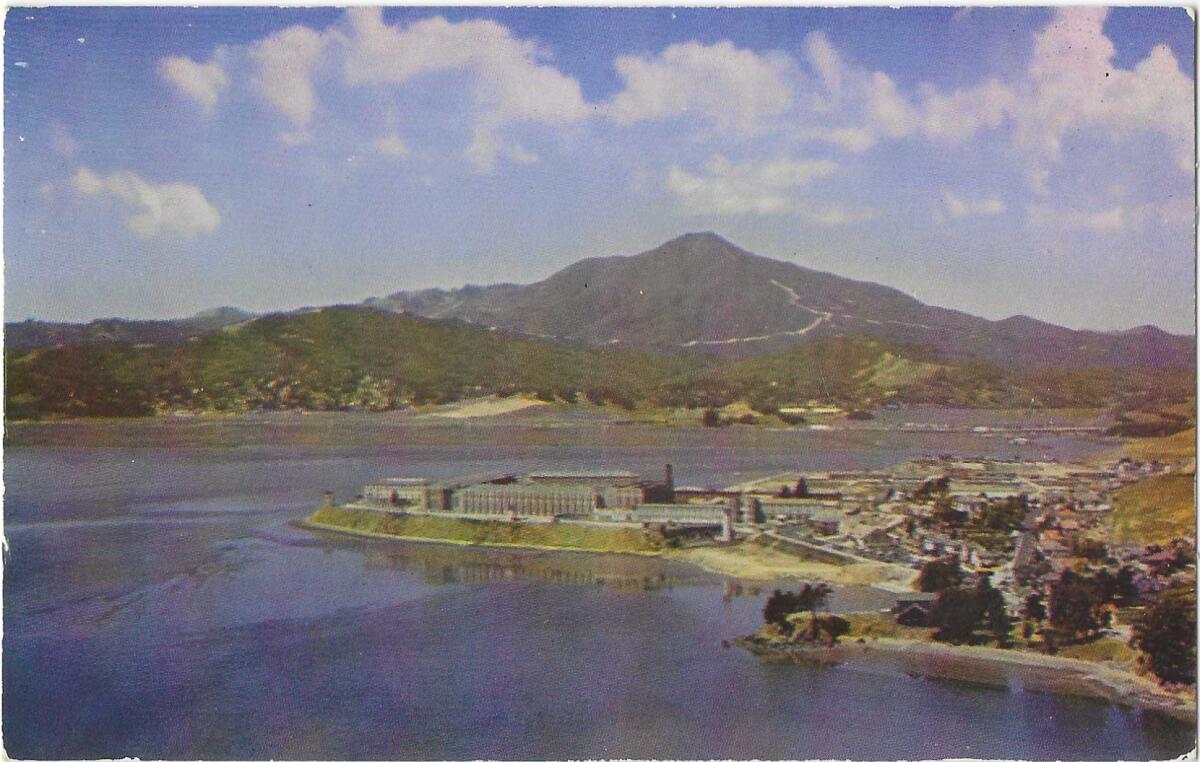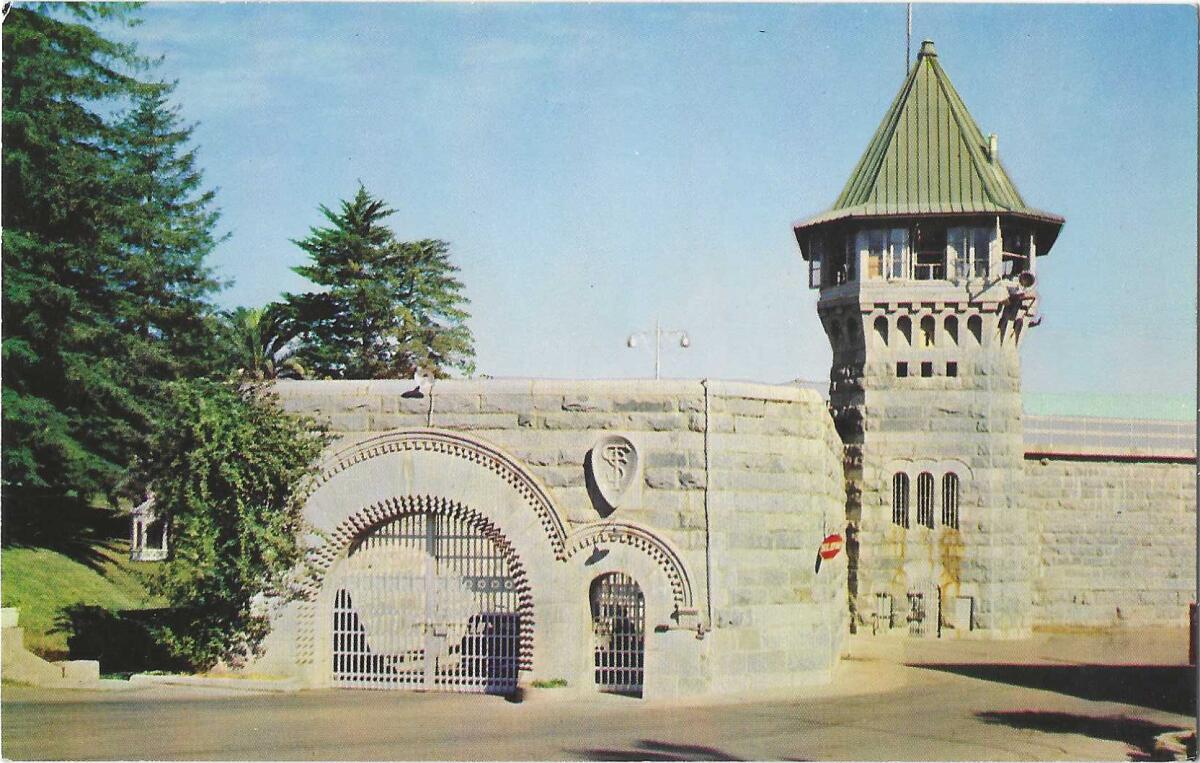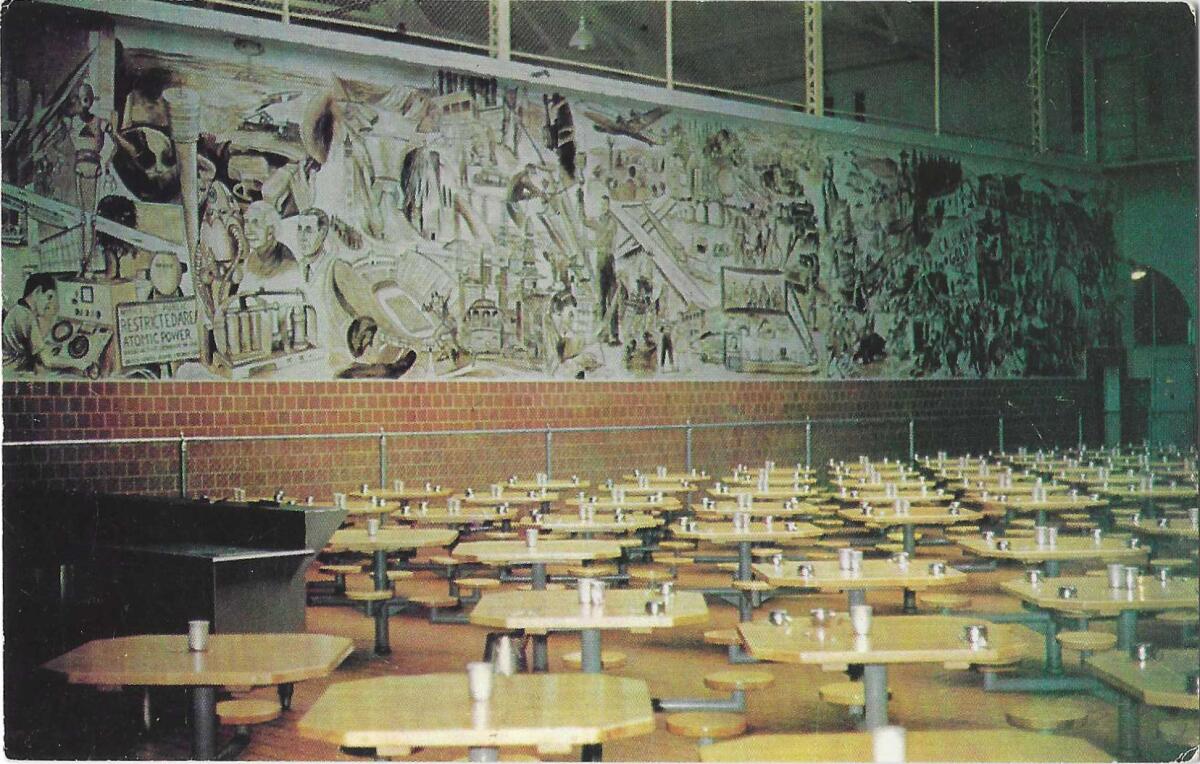California is closing San Quentin’s death row. This is its gruesome history

- Share via
Could this be the end of the line for the end of the line?
Three years after an executive order from Gov. Gavin Newsom slammed the brakes on executions in California, which hasn’t put anyone to death in 16 years anyway, California’s death row is about to be slowly dismantled. Its 737 residents, all still technically under sentence of death, are slowly being moved away from the condemned cells at San Quentin, a place where California has, by three successive methods — the noose, the gas and the needle — put men and women to death since 1893.
These slow-mo evictions are what voters OKd in 2016 when, at the same time they ordered the state to speed up the death penalty, they also agreed to moving the condemned to other prisons, emptying out the most infamous section of one of the most infamous prisons in the nation.
The California death penalty has whipsawed the state’s politics and laws and voters for decades. Over that time, sentiment has swung back and forth. Ballot measures to ban it outright have crept closer to winning. Yet just let a court throw out a particular execution method, or any executions at all, and voters or legislators will put the death penalty right back on the books again.
One California chief justice, Rose Bird, voted to overturn every death penalty case she reviewed. She was booted from the bench — as were two of her fellow justices — when she ran for reelection in 1986, in a campaign that was staggering for the millions that conservatives spent to get rid of her.
Explaining L.A. With Patt Morrison
Los Angeles is a complex place. In this weekly feature, Patt Morrison is explaining how it works, its history and its culture.
Until pretty recently, endorsing the death penalty has been a weirdly un-liberal carve-out position taken by some otherwise blue politicians. Tom Bradley, the first and so far only Black mayor of L.A., who had also been an LAPD cop, made it clear a year before his second run for governor: “To put it neatly and in a few words, I am in favor of the death penalty.” Endorsing capital punishment helped Dianne Feinstein to get elected and reelected to the Senate, but running again in 2018, she did an about-face, for reasons from unequal sentencing to factual innocence. And the 1960 execution of a notorious inmate divided a father and son — the Democratic governor, Pat Brown, and his Democratic son, the future Gov. Jerry Brown. Both opposed the death penalty, but the governor pointed out that the state Constitution tied his hands when it came to giving that man clemency.
Death row has been emptied before. Twice in the 1970s, the state and U.S. supreme courts essentially voided the death penalty as cruel and unusual, and the residents of death row were given new addresses, and new sentences. Some of them became life without possibility of parole, but some — controversially, Charles Manson and his convicted “family,” and assassin Sirhan Sirhan — with a prospect of parole, at least on paper. Again and again, voters and lawmakers roared back with death penalty laws to accommodate the courts’ objections.
But the intervals between executions were growing longer. In April 1967, condemned cop killer Aaron Mitchell slashed his forearm with a piece of metal and proclaimed, “I am the second coming of Jesus!” Then, right before his execution, he opened his wounds, smeared blood on his palms and stood naked in a crucifixion pose chanting, “This is the blood of Jesus Christ.… I am going to save the world.” Artist Howard Brodie, sketching the execution for TV news, said of Mitchell’s execution, “I’ve covered four wars and witnessed the execution of three enemy soldiers during the Battle of the Bulge. But I’ve never seen anything more dehumanizing.”
California would not execute another prisoner for a quarter-century, and then it was a man whose crime, murdering two 16-year-old San Diego boys after he robbed a bank, was of indelible callousness. Robert Alton Harris mocked one boy’s desperate prayers, told them both to “stop crying and die like men,” flicked their flesh off his gun afterward, and ate their Jack in the Box burgers and fries.
After Harris’ execution by poison gas, lethal injection became first the preferred, then the only method of death, and that infamous chamber — variously described as jade green or apple green or hospital green, and for a while going by the inmates’ nickname “the smokehouse” — closed down.
Another dozen executions followed, under Democratic and Republican governors, until the last, in January 2006. The next year, work began on a lethal injection chamber that complied with legal rulings about pain and suffering, but it has never been used. In 2019, Newsom ordered it to be shut down.

California’s death row, like the state itself, is the nation’s most populous. Its wardens and guards have told stories over the decades of condemned men they remembered most: One prisoner nicknamed “Soldier” for having served in World War II under Gen. Dwight D. Eisenhower was executed shortly before “Ike” became president and carried Eisenhower’s picture with him to the gas chamber door.
In 1956, another man, Robert Pierce, told fellow inmates that he would “go out the hard way.” He slashed his own throat with a 3-inch bit of broken mirror he had hidden in the spine of a book, and prison guards dragged and carried him to the gas chamber, blood spurting over them and Pierce’s white shirt as he fought and swore.
In 1944, Farrington Hill wanted to hear the Strauss waltz “Tales From the Vienna Woods” one more time. But it wasn’t on the prison library’s shelves and the record stores were closed. So the warden assembled the prison band, which made a quick record that Hill played all night and right up to the gas chamber door.
Thanks chiefly to Hollywood movies, the public might know about the 1955 execution of Barbara Graham, convicted of her part in the murder of a Burbank widow, and portrayed to Academy Award-winning effect by Susan Hayward in “I Want to Live!” California has put four women to death, among them a ruthless gangster named Juanita Spinelli, who went to the gas chamber in November 1941 with photographs of her children and grandchild taped over her heart beneath her new green dress.
Moviemakers, painters and authors have long opined on the quality of L.A.’s light. A Caltech scientist illuminates on why our light is so remarkable.
The death sentence of Caryl Chessman, the Los Angeles-area “Red Light Bandit,” was an international phenomenon in part because of Chessman himself, a self-made media star. He claimed descent from the poet John Greenleaf Whittier, and in his dozen years on death row, he wrote books — one of which was made into the movie “Cell 2455 Death Row” — gave interviews, and generated an outcry on his behalf by death penalty protesters the world over, and right outside the prison gates. Figures like Billy Graham, Eleanor Roosevelt and Ray Bradbury appealed for clemency.
Chessman had killed no one. He was convicted of robbery, rape and kidnapping at a time when kidnapping with bodily harm carried a possible death sentence. Chessman filed myriad appeals, one of which got to the Supreme Court, and won stays of execution, but he was put to death in the gas chamber in May 1960. A year and a half later, a man convicted of kidnapping and rape was put to death — the last execution for crimes in which no one was killed.
California law now can impose a death penalty only in deadly crimes with special circumstances, including perjury in order to get an innocent person killed. (Treason remains a capital crime in California, although what constitutes treason under state law is hard to conjure.)
Some of the most prominent opponents of capital punishment — or at least of the means of carrying it out — were San Quentin wardens. Lawrence Wilson was warden when Aaron Mitchell was executed, and that changed his point of view to against capital punishment. There were, he said, too many instances where “the economic, social or political standing” determines a death sentence.
Former warden Clinton T. Duffy, who wrote a book about his San Quentin years, agreed: “I have never heard of a rich man being executed in this state — a man with means enough for a good defense.” Capital punishment “is not equal justice.” He “hated” the death penalty.

For the first 40 years of California statehood, it was the counties, not the state, that executed the condemned. That doesn’t take into account all the tree-stump rough justice meted out in mining camps and in outraged towns, the hangings of the guilty and the innocent.
About a dozen years after statehood, when L.A. was almost living up to its reputation as a murder-a-day town, locals had no faith that the rudimentary court system was up to the task and formed their own “vigilance committee.” One lynching, in 1863, is typical of many. It was described years later in the Santa Monica Outlook by an Angeleno named H.D. Barrows. The vigilantes snatched the killer right out of the courtroom, where he’d just been convicted of murdering the brother-in-law of the shipping pioneer Phineas Banning.
As the guilty man, Charles Wilkins, was about to be taken back to jail, a mob surged into the courtroom. Banning himself, Barrows remembered, was the first to reach the platform to seize Wilkins, who became “the sixth or seventh victim of the outraged and exasperated people of Los Angeles within the space of a month.” Just a few weeks earlier, nearly 300 armed men — a huge chunk of a city population of 4,800 — had broken down the jail’s metal-barred doors and carried off five men and hanged them. Now, as the mob carried off Wilkins to a corral at about the spot where Spring Street crosses the 101 Freeway, Wilkins “begged them to shoot him and not hang him.” But hang he did.
An entire generation later, in August 1892 in Santa Ana, a man was lynched and hanged for killing a ranch foreman. After a secret planning meeting, perhaps three dozen armed men broke down the jail door and made off with Francisco Torres. They hanged him from a telephone pole about a block from the jail, a half-inch cord looped around his neck and a cardboard sign pinned to his shirt. It read: “A change of venue.”
As you get used to separating your food waste from the rest of your trash, consider how far L.A. has come with its garbage since the days of backyard incinerators.
Whether it was the counties or the state doing the executing, they were required to carry out executions “within the walls or yard of a jail, or some convenient private place in the county.”
And yet the public found ways to watch.
For the double hanging of two murderers in downtown L.A. in March 1885, the sheriff built a canvas-covered frame like a stage set, 20 feet square and 7 feet tall to block what The Times called “promiscuous sight-seeing.”
Nonetheless, the slopes of nearby hills and the roofs of nearby buildings were crammed with voyeurs. Men stood at the jail fence digging splintery peepholes with their jackknives. It was, The Times wrote, “a pitiful commentary upon humanity.”
At least 6,000 people — maybe half the city’s population — was supposed to have been trying to gawp as Rodolfo Silvas and Francisco Martinez were led out. The men knelt before a priest and shook the hand of deputy sheriff Martin Aguirre — a legendarily courageous one-eyed lawman who would become L.A. County’s first Latino sheriff and eventually warden at San Quentin. The black hoods were placed over the men’s heads, and with a downward swoop of his hat, the sheriff signaled the hangmen, and both men dropped.
It was, The Times was at pains to point out, the first legal execution in the county in a generation, and perhaps the last in L.A. County before the state took over execution duties in 1891, carrying out judicial hangings in both San Quentin and Folsom until the gas chamber in San Quentin became the sole place and method in 1938.
The gas chamber was tested first on a prison pig. The pig took 35 minutes to die, but prison officials reassured the world that it would take “nowhere near” that time for a man to die. A December 1938 timing test run of the new gas chamber with a couple of prison guards stripped to their shorts, strapped in and sealed inside left the warden, Court Smith, queasy. “Hanging is bad enough. But this — it’s terrible.” It is, Smith said, “my duty to do so; otherwise I would take no hand in this performance.”
In a quirk of legal timing, two men were executed on the same day in December 1938. But one was hanged, because he had been sentenced before the legal switch to the gas chamber, and the other was gassed, because he was sentenced after the changeover.

Death rows have generated their own mythic subculture of music, parting words and even a kind of food porn, memorialized in a book called “Last Suppers.” At virtually every execution, California reporters solemnly noted the menus of the doomed: Silvas and Martinez ate a meal brought over from Eckert’s restaurant nearby, on Court Street: oysters, ham and eggs with fried potatoes, broiled chicken well done with fried onions, bread, pie, pickles and a bottle of wine.
That last item hasn’t been on offer to the condemned for a long time, although in December 1938, the first two men put to death in the gas chamber, side by side, asked for and got a cigar and a shot of whiskey each 10 minutes before they went to their deaths.
In the last couple of years, COVID-19 has killed at least a dozen California death row inmates, more than the state has put to death in about 30 years, and while it’s never a good bet to predict what California voters might do, the latest changes in law and practice might — just might — make the death penalty the 514th and last of the list of the San Quentin dead.
L.A. is a place like no other. You’ve got questions. Patt Morrison probably has answers and can definitely find out.
More to Read
Sign up for Essential California
The most important California stories and recommendations in your inbox every morning.
You may occasionally receive promotional content from the Los Angeles Times.















